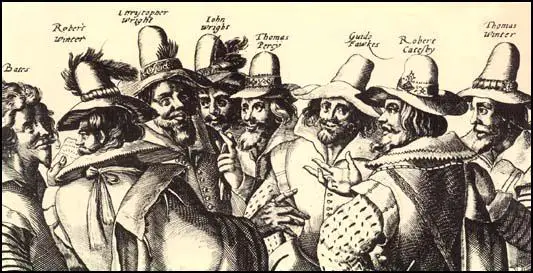Francis Tresham
Francis Tresham, the eldest son of Sir Thomas Tresham, the Sheriff of Northamptonshire, was born in about 1567. He was educated at Cambridge University but as a Roman Catholic he was unable to graduate.
In August 1581, Sir John Tresham was arrested for harbouring Catholic priests and spent the next seven years in Fleet Prison. He was also heavily fined for acts of recusancy. In 1591 Francis Tresham was also arrested and spent time in prison.
In 1596 Elizabeth I became ill. As a precautionary measure, a group of leading Roman Catholics, including Francis Tresham, Christopher Wright, Robert Catesby and John Wright were arrested and sent to the Tower of London.
Tresham was also involved with Robert Devereux, Earl of Essex, in the failed attempt to remove Elizabeth I from power in 1601. Due to the minor role he played in the rebellion he was not executed and instead spent time in prison.
In 1605 Robert Catesby devised the Gunpowder Plot, a scheme to kill James and as many Members of Parliament as possible. Catesby planned to make the king's young daughter, Elizabeth, queen. In time, Catesby hoped to arrange Elizabeth's marriage to a Catholic nobleman. Catesby recruited Francis Tresham to join the conspiracy.

Catesby's plan involved blowing up the Houses of Parliament on 5 November. This date was chosen because the king was due to open Parliament on that day. At first the group tried to tunnel under Parliament. This plan changed when a member of the group was able to hire a cellar under the House of Lords. The plotters then filled the cellar with barrels of gunpowder. Guy Fawkes was given the task of creating the explosion.
Francis Tresham was worried that the explosion would kill his friend and brother-in-law, Lord Monteagle. On 26th October, Tresham sent Lord Monteagle a letter warning him not to attend Parliament on 5th November.
Monteagle became suspicious and passed the letter to Robert Cecil, the king's chief minister. Cecil quickly organised a thorough search of the Houses of Parliament. While searching the cellars below the House of Lords they found the gunpowder and Guy Fawkes. He was tortured and he eventually gave the names of his fellow conspirators.
Francis Tresham was arrested on 12th November. He wrote a full confession about his involvement in the Gunpowder Plot. However, many people believed he was working as a double agent for Robert Cecil.
Francis Tresham died in the Tower of London on 22nd December, 1605. Officially death was caused by a blockage of the urinary tract. However, rumours circulated that he had been poisoned by Lord Monteagle.

